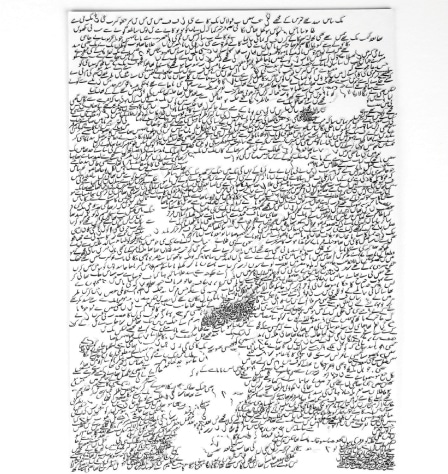
For the past few years, the Canvas Gallery has been presenting some exceptional art of both established and emerging Pakistani artists to London audiences, in association with the Grosvenor Gallery, London. This exposure of Pakistani artists to wider audiences is imperative as there is accelerated development within the contemporary art scene. That being said, the latest Canvas/Grosvenor collaboration saw the work of Ghulam Mohammad (of Jameel Prize 2016 fame) exhibited in a long overdue solo show in London.
Mohammad’s art practice — like the artist himself — is subtle and nuanced, with a kind of intricacy that draws the viewer in. Mohammad explores the formation of identity through language in a meticulous and labour-intensive manner. His idea emerged from his personal experience of life in Pakistan. The artist’s practice is a culmination of his educational experiences at different levels and cities in Pakistan. Born and raised in Balochistan, he learnt five different languages when growing up, excluding Urdu or English. His mother tongue, Balochi, was acquired during his formative years at home. At school, the medium of communication changed and he had to learn Urdu, the national language. Ultimately, for graduate level education at Beaconhouse National University in Lahore, where the main medium of education was English, he learnt this new language in order to progress.
His oeuvre expresses this journey of negotiating environs and languages that led to the shaping of his identity as an individual and artist. For him, language has been as much a barrier as a mode of communication, where articulation is tough because of the various layers of meaning that need deciphering. The exhibition Peeha (Grind) is the story of his evolution. Unintentionally, it speaks of the divide in Pakistani society and communities at large, thus his work is political as well.
Ghulam Mohammad draws parallels between Ghalib’s poetry and his own struggle with language as a medium of expression
Mohammad’s visuals are a delight to behold, and they demand awe, not only because they are stunning but also because they reflect the painstaking process with which each piece is produced. The raw material for Mohammad’s pieces comes from discarded books and papers at Lahore’s Anarkali bazaar. One such foray into a discarded pile of paper led him to Mirza Ghalib’s poetry. The work in Peeha is a repurposing of text from these found pages of poetry; the artist cut out the letters, words and sentences from the pages and then re-arranged them on vasli in a manner that they make up Urdu text.

Peeha consists of calligraphic writing of the first verse of Ghalib’s Diwan Naqsh Faryadi Hai Kis Ki, distributed amongst four different pieces titled ‘Aaj ka Ghalib I, II, III and IV’. Mohammad points out that the readable and identifiable text is actually blank space on paper i.e. negative space. The minute cut-outs of Urdu text, collaged in a deliberately chaotic, overlapping clutter frame negative space in a way that it forms words and sentences. The stark black-and-white compositions, with random letters floating about the surface, hanging off the edge of the sheet, occasionally placed atop each other forming little mounds, are reminiscent of ants forming shapes and patterns as they crawl around cubes of sugar.
However, Mohammad’s assemblages cannot be easily categorised as collages. His pieces have a three-dimensional feel to them; as tiny as the text is, some of it is held down by just a sliver of its body, with bits sticking up from the surface of the sheet, while simultaneously overlapping other text to build volume. This deliberate construction of text in the visuals resonates with the unusual perspectives of miniature paintings referred to as the fourth dimension. Another feature of the work not included in the description of the medium, are the acrylic frames designed by the artist himself. Because of the clear acrylic material framing the collages, it appears as though one is looking through a magnifying glass at a detail of minute letter-shaped pixels of ink that form words.

To inform his practice, the artist has researched Ghalib extensively, and draws parallels between Ghalib’s poetry and his own struggle with languages to express his emotions and feelings. As is suggested by the title of his pieces, Mohammad believes that the meanings extracted from Ghalib’s poetry evolve with time and are understood differently in different periods of time. The artist’s sympathies are with Ghalib, the castigated poet who produced exceptional work.
Mayfair’s Grosvenor Gallery is widely recognised for exhibiting art from South Asia and their recent foray into Pakistani art is an exciting development. With showcases such as Peeha, they have firmly established themselves as presenters of contemporary Pakistani art.
“Peeha” is on display at Mayfair’s Grosvenor Gallery in London from May 11 to May 29, 2018
Published in Dawn, EOS, May 27th, 2018















































Dear visitor, the comments section is undergoing an overhaul and will return soon.